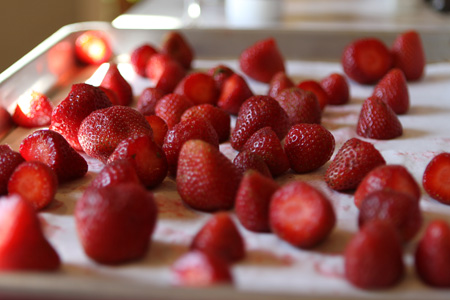June 25, 2010

As we head into summer I am almost already overwhelmed by the abundance offered from my garden. Strawberries are spilling over my brick garden walls, tomatoes are dropping from their trellised domiciles and green beans are quickly shooting from once flowering stalks. And I have been on the road, traveling with the children, enjoying the break from the school year and the luxury of lengthy pajama clad mornings. These lazy days motivate me to do just about nothing.
One thing I do, do (yes, I said do-do) is freeze whatever abundance I know we won’t have the opportunity to eat while it’s fresh; it’s a lot easier and quicker than canning so it is my preserving method of choice. Believe it or not, there is a correct and an incorrect way to freeze, and it’s just as easy to do it the right way as the wrong. So pay attention and avoid freezer burn and clumping for tastier end results.
Tips for freezing:
I freeze tomatoes, green beans and strawberries whole. With zucchini I freeze diced or bite-sized pieces. Just remember to dry the pieces thoroughly after you cut them — I press a towel to the zucchinis to soak up any extra moisture. This technique can be used to freeze just about anything. If I have any pitted fruit left over (which is hardly ever), I cut them in half, remove the pits, and then freeze them in halves or quarters to use for pies or crumbles at a later date.
• Wash and dry well with cloth towels.
• Remove stalks or stems.
• Lay out your produce on a cookie sheet lined with parchment paper — don’t allow your fruit or vegetables to touch each other.
• Slip that entire cookie sheet (uncovered) into the freezer and freeze until your produce is frozen solid — depending on size this can take anywhere from one to five hours.
• Pour your now frozen produce into a freezer safe bag (date it!) and store for up to 6 months.
Use as you would any frozen veggies. The kids enjoy the berries, grapes, and most veggies still frozen!